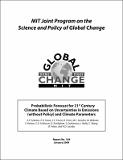Probabilistic Forecast for 21st Century Climate Based on Uncertainties in Emissions (without Policy) and Climate Parameters
Author(s)
Sokolov, Andrei P.; Stone, Peter H.; Forest, Chris Eliot; Prinn, Ronald G.; Sarofim, Marcus C.; Webster, Mort D.; Paltsev, Sergey; Schlosser, C. Adam.; Kicklighter, David W.; Dutkiewicz, Stephanie.; Reilly, John M.; Wang, Chien.; Felzer, Benjamin Seth.; Jacoby, Henry D.; ... Show more Show less
DownloadMITJPSPGC_Rpt169.pdf (1.062Mb)
Metadata
Show full item recordAbstract
The MIT Integrated Global System Model is used to make probabilistic projections of climate change from 1861 to 2100. Since the model's first projections were published in 2003 substantial improvements have been made to the model and improved estimates of the probability distributions of uncertain input parameters have become available. The new projections are considerably warmer than the 2003 projections, e.g., the median surface warming in 2091 to 2100 is 5.1°C compared to 2.4°C in the earlier study. Many changes contribute to the stronger warming; among the more important ones are taking into account the cooling in the second half of the 20th century due to volcanic eruptions for input parameter estimation and a more sophisticated method for projecting GDP growth which eliminated many low emission scenarios. However, if recently published data, suggesting stronger 20th century ocean warming, are used to determine the input climate parameters, the median projected warning at the end of the 21st century is only 4.1°C. Nevertheless all our simulations have a very small probability of warming less than 2.4°C, the lower bound of the IPCC AR4 projected likely range for the A1FI scenario, which has forcing very similar to our median projection. The probability distribution for the surface warming produced by our analysis is more symmetric than the distribution assumed by the IPCC due to a different feedback between the climate and the carbon cycle, resulting from a different treatment of the carbon-nitrogen interaction in the terrestrial ecosystem.
Description
Abstract and PDF report are also available on the MIT Joint Program on the Science and Policy of Global Change website (http://globalchange.mit.edu/).
Date issued
2009-01URI
http://globalchange.mit.edu/pubs/abstract.php?publication_id=990http://hdl.handle.net/1721.1/44627
Publisher
MIT Joint Program on the Science and Policy of Global Change
Citation
Report no. 169
Series/Report no.
;Report no. 169;Report no. 169